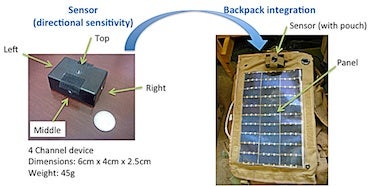
The US Naval electronics science and technology division research scientists have developed a new low-cost, highly-efficient spectral sensor, to measure the amount of solar irradiation (sunlight) visible to photovoltaic panels.
Designed for field analysis of solar cell irradiance performance and spectral distribution, the sensor system can be used in remote solar radiation monitoring applications, including mobile solar power units.
Working in the solid state sevices section of the laboratory, Dr. R. Hoheisel said the new minimum size, ultra-low power spectral radiometre unit features integrated data storage functionality and a battery lifetime of up to several years.
"In addition, the system can be produced at the expense of under $20 and features very high sensitivity and linearity," Hoheisel said.
The sensor can be tailored to suit the end-user needs and can also be used in long-term environmental monitoring systems where high-precision and low-power consumption is required.
In addition, the modularity enables the system to adjust to different wavelength bands as well as different light intensities as required for the user.
The completely autonomous operational sensor system facilitates wider operational range of solar radiation measurement units, which leads to better understanding as well as reliable and accurate forecasts of available solar power for various mission profiles.
"These units have a dynamic range of 0.01 – 2 suns measured in 30-second intervals, a data capacity of 128MB, an average power consumption of 100uW and an independent real time clock."
The photovoltaic system has been developed and prototyped by the US Marine Corps (USMC) expeditionary energy office (E2O) to meet the requirements of USMC expeditionary power for robust, high-efficiency solar panels, which are appropriate for adaptation to rechargeable batteries in the field.
The research is also contributed by the USMC E2O and the office of naval research (ONR) expeditionary and irregular warfare office.
Image: a mobile solar power unit pack attached with solar sensor boxes. Photo: courtesy of the US naval research laboratory.





